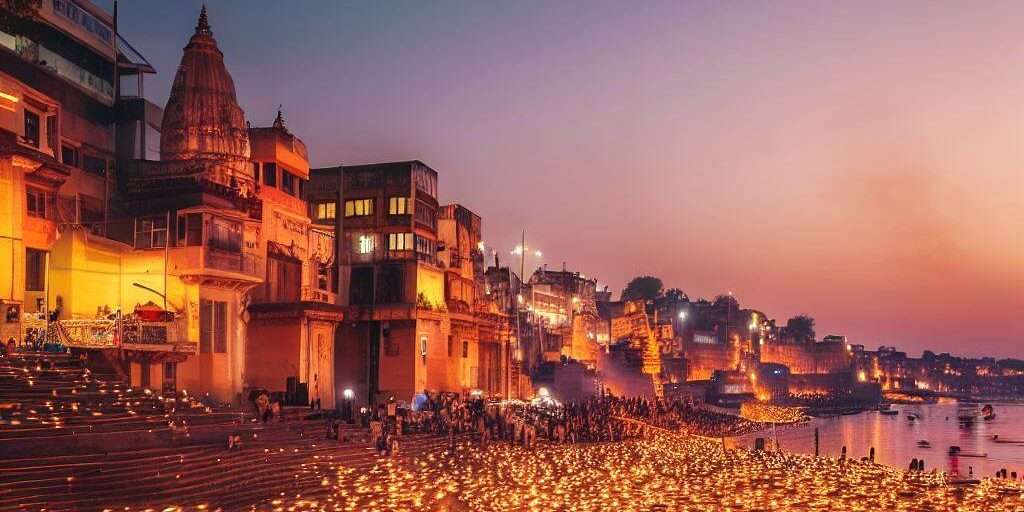Unveiling the Spiritual Significance of 6 Hindu Holy Cities


A mesmerizing night view of the ghats in Varanasi, one of the significant Hindu Holy Cities.
Introduction
Hinduism, one of the oldest religions in the world, has always been more than a belief system. It’s a way of life, a philosophical guide, and a cultural tapestry intertwined with India’s history. This richness is displayed, among many things, in the holy cities of Hinduism—spaces of profound spirituality and cultural vibrancy.
Exploring these Hindu Holy Cities provides an extraordinary insight into the core of Hindu belief systems, the depth of its mythology, and the vibrancy of its rituals. This blog aims to take you on a journey through six such cities—Varanasi, Allahabad, Mathura, Vrindavan, Haridwar, Rishikesh, and Puri—and unveil their spiritual significance.
Varanasi: The Eternal City of Shiva
Varanasi, often referred to as the ‘Eternal City’ or ‘City of Light’, is considered one of the holiest cities in Hinduism. The city, which emanates an air of timeless existence, is named after the two tributaries of the Ganges—Varuna and Asi—which flank the city on the north and south, respectively.
Varanasi’s history intertwines with the mythology of Lord Shiva, one of the principal deities in Hinduism. It is believed that Shiva established Varanasi as his abode, making it a significant pilgrimage destination. Many devotees take a holy dip in the sacred Ganges River, which flows through the city, believing that the waters can absolve one’s sins and liberate them from the cycle of rebirth.
In the winding lanes of Varanasi, rituals and ceremonies are a daily spectacle. From the early morning ‘Ganga Aarti’ to the evening prayers, the city buzzes with a spiritual energy. Varanasi is also home to over 2,000 temples, including the famous Kashi Vishwanath Temple, a major draw for pilgrims and tourists alike.
Allahabad: The Confluence of Three Holy Rivers
Allahabad, also known as Prayagraj, holds a revered place in Hinduism as the meeting point of three holy rivers—Ganga, Yamuna, and the mythical Saraswati, forming the ‘Triveni Sangam’. Hindus from across the globe visit Allahabad to bathe in this Sangam, aiming for spiritual cleansing and liberation.
The city is renowned for hosting the Kumbh Mela, one of the largest religious gatherings in the world. During this event, millions of devotees and spiritual seekers descend upon Allahabad to engage in sacred rituals and ceremonies. Bathing during the Kumbh Mela is believed to rid individuals of their sins and help them attain Moksha (liberation).
Allahabad’s landscape is dotted with a myriad of cultural and religious sites, from ancient temples to royal forts. Every corner of the city reverberates with an age-old spiritual legacy.
Mathura and Vrindavan: The Birthplace and Playground of Lord Krishna
A few hours’ drive from the hustle and bustle of Delhi takes you to Mathura and Vrindavan, twin cities with a profound spiritual heritage. They are closely associated with Lord Krishna, one of the most loved deities in Hinduism, known for his playful antics and profound wisdom.
Mathura, believed to be the birthplace of Krishna, and Vrindavan, where he spent his childhood and youth, are revered pilgrimage sites. Both cities host numerous temples dedicated to Krishna, including the Dwarkadhish Temple in Mathura and the Banke Bihari Temple in Vrindavan.
Holi, the festival of colors, and Janmashtami, Krishna’s birthday, are celebrated with fervor here. Pilgrims and tourists from around the globe converge on these cities to experience their spectacular cultural vibrancy.
Haridwar: Gateway to the Gods
Haridwar, aptly named as the ‘Gateway to the Gods’, is a major pilgrimage city located on the banks of the River Ganges. The city’s spiritual significance lies in its association with the Samudra Manthan, a mythological event where gods and demons churned the ocean to obtain the nectar of immortality.
The city is renowned for the Kumbh Mela and Ardh Kumbh Mela, where devotees from all walks of life participate in holy rituals and ceremonies. Haridwar’s famous ghat, Har Ki Pauri, is a spiritual nerve center where daily rituals such as the Ganga Aarti draw in throngs of pilgrims and tourists. Beyond this, the city is home to several ashrams and temples, making it an important center for Hindu teachings and philosophy.
Rishikesh: The Yoga Capital of the World
Nestled in the foothills of the Himalayas, Rishikesh is not just another one of the Hindu Holy Cities—it’s globally recognized as the ‘Yoga Capital of the World’. This city, with its serene landscape and spiritual ambiance, has been a magnet for spiritual seekers for ages.
It’s also famously associated with The Beatles, who visited the Maharishi Mahesh Yogi’s ashram in 1968, a trip that dramatically transformed their music and popularized Transcendental Meditation worldwide.
Rishikesh’s spiritual atmosphere is complemented by the teaching and practice of yoga and meditation, with numerous ashrams offering courses and retreats. The city also offers a blend of spiritual and adventure tourism, with options like white-water rafting and trekking in the beautiful mountain trails.
Puri: The Abode of Lord Jagannath
Puri, located on the eastern coast of India, is a revered city known as the ‘Abode of Lord Jagannath’. The spiritual significance of Puri stems from the grand Jagannath Temple, one of the ‘Char Dhams’ (four sacred abodes) in Hinduism.
Every year, the city hosts the Rath Yatra or the Chariot Festival, a magnificent event where the deities of the temple are taken out in grand processions. Thousands of devotees pull the massive, intricately decorated chariots, showcasing their devotion.
Puri is not only about spirituality—it also offers stunning beaches and the ecological wonder of Chilika Lake, Asia’s largest brackish water lagoon, home to a diverse range of flora and fauna.
Summary
The Hindu Holy Cities of Varanasi, Allahabad, Mathura, Vrindavan, Haridwar, Rishikesh, and Puri serve as windows into the spiritual heart of India. They symbolize the essence of Hinduism, showcasing a harmony of mythology, spirituality, culture, and rituals that have withstood the test of time.
Frequently Asked Questions (FAQs)
What are the main pilgrimage sites for Hindus in India?
The main pilgrimage sites for Hindus in India are the ‘Char Dhams’—Badrinath, Dwarka, Puri, and Rameshwaram—and the seven holy cities, also known as the ‘Sapt Puri’—Varanasi, Haridwar, Ayodhya, Mathura, Kanchipuram, Ujjain, and Dwarka.
How can I participate in the Kumbh Mela?
To participate in the Kumbh Mela, you need to be aware of the event dates, which occur every three years in rotation between four cities: Haridwar, Prayagraj, Nashik, and Ujjain. Foreign visitors can easily participate by joining a tour group or by going independently, keeping in mind that accommodations should be booked well in advance due to high demand.
Are these holy cities open to tourists from all religions?
Yes, these holy cities are open to tourists from all religions. However, non-Hindus may not be allowed to enter certain temples or participate in specific rituals. Respect for local customs and traditions is expected from all visitors.
Can you suggest some lesser-known holy cities in India?
Apart from the well-known holy cities, there are several lesser-known yet equally significant spiritual destinations in India. These include Kanchipuram in Tamil Nadu, known as the ‘City of Thousand Temples’, Ujjain in Madhya Pradesh, known for the Mahakaleshwar Jyotirlinga, and Dwarka in Gujarat, associated with Lord Krishna.
What are some cultural practices and traditions in these holy cities?
Each holy city has its unique set of cultural practices and traditions. From the evening Ganga Aarti in Varanasi and Haridwar to the celebration of Holi in Mathura and Vrindavan, from the Rath Yatra in Puri to the yoga traditions in Rishikesh—each city offers a distinctive cultural experience.
Conclusion
Hindu Holy Cities, steeped in mythology and spirituality, offer a captivating exploration of India’s spiritual heritage. They provide unique insights into Hinduism and its multi-faceted cultural and spiritual traditions. Visiting these cities is akin to embarking on a spiritual odyssey—one that provides a deeper understanding of life, death, and the divine. Whether you’re seeking spiritual enlightenment, cultural immersion, or historical exploration, these cities are sure to leave an indelible impression on your mind.
Further reading
Holy Places: https://iskconeducationalservices.org/HoH/practice/pilgrimage/holy-places/
Recent Posts
5 Key Insights: The Significance of Yoga in Modern Life from a Hindu Perspective
Yoga, an ancient practice rooted deeply in the spiritual soil of Hinduism, has traversed a…
10 Transformative Reasons: The Spiritual Guide to Eating with Hands in Hinduism
Introduction In the age of fast food and instant gratification, the serene practice of eating…
10 Unbreakable Connections Between Hinduism and Environmental Sustainability: A Comprehensive Guide
Introduction Hinduism, one of the world's oldest religions, is more than a mere spiritual path;…
7 Timeless Principles of Non-Violence in Hinduism: A Comprehensive Guide
Introduction: Embracing Non-Violence in Hinduism The Profound Connection Between Non-Violence and Hinduism Non-violence, or Ahimsa,…
7 Transformative Powers of Yagya in Hinduism: A Complete Guide to Spiritual Rituals
Introduction to Yagya in Hinduism: A Spiritual Exploration Yagya, also spelled Yajna, is a profound…
The Deep-rooted Significance of Copper in Hinduism: 7 Enlightening Insights
Introduction Copper, with its gleaming reddish-brown allure, isn't just a metal to the spiritually profound…
